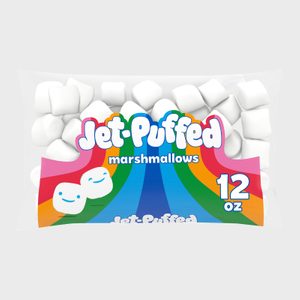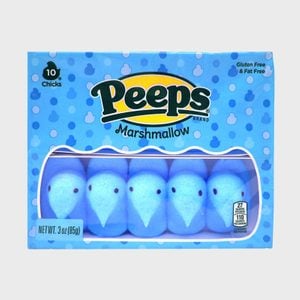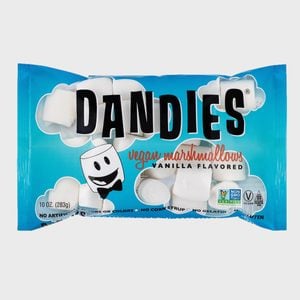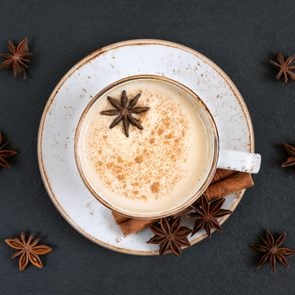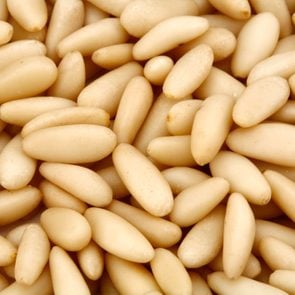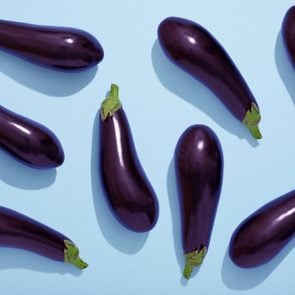What Are Marshmallows, Exactly?
Updated: Aug. 10, 2023
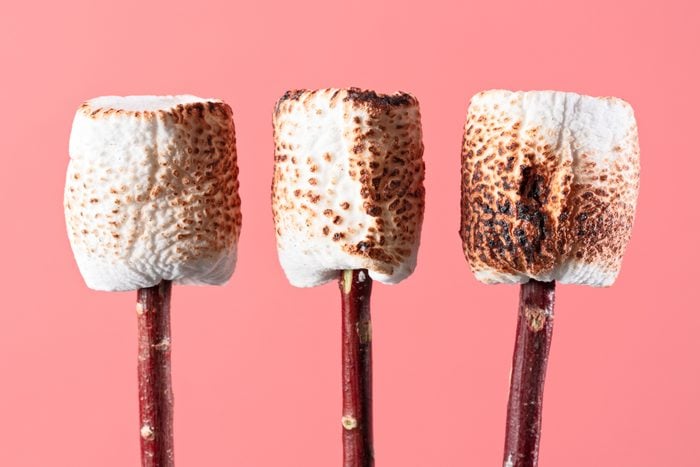
This isn't just a puff piece! We're getting to the bottom of the bag to find the answer to one question: What are marshmallows made of?
Our editors and experts handpick every product we feature. We may earn a commission from your purchases.
We know that marshmallows improve almost any situation. They’re the best fireside camping treat, they melt perfectly into hot chocolate, and they can even make cookie recipes better. But when it comes to the ingredient list, marshmallows are one big, puffing mystery. What are marshmallows made of? It’s a food facts trivia question with a surprising answer. We have a feeling that it probably doesn’t include a ton of vitamins and minerals, but so many of our favorite treat foods don’t. See: the history of ice cream and what’s actually in white chocolate.
If nothing else, we know that marshmallows give us (and our kids) a quick burst of energy, and a super-size bag of them makes an excellent pillow for car naps on the way to the campsite. Just be sure and keep them away from all ghosts and ghostbusters! These marshmallows are for eating—as soon as we figure out what’s in them.
What are marshmallows?
They’re called malvavisco in Spanish, and guimauve in French, but there’s no doubt that marshmallows have come to be thought of as primarily American. After all, we eat more than 90 million pounds of them annually!
Marshmallows are chewy, airy, stretchy, melty, gooey, puffy, and sweet confections. They’re related to gummy bears and other gummy candies, as well as Jell-O. Maybe they’re even the best candy for your zodiac sign. Although modern marshmallows have been developed with the wonders of food science, they have a surprisingly ancient history that stretches back to the Ancient Egyptians. (More on that below.) But marshmallows as we know and love them in the 21st century? A regular marshmallow is basically a foam, sweetened with sugar and corn syrup, fluffed up by air, and stabilized with gelatin, which gives it that elastic stretch.
Marshmallow ingredients
There are just four marshmallow ingredients: sugar, air, corn syrup, and gelatin. The answer to the question “What are marshmallows made of?” is surprisingly simple. You can even make homemade marshmallows with just a little bit of effort. The gelatin is probably the most important ingredient. It’s the thing that gives marshmallows their gooey, stretchy, elastic, puffy, bouncy properties. Gelatin also melts at just below body temperature—about 95 degrees Fahrenheit—which is why it melts in your mouth (and burns on your campfire, if you’re not careful!).
Despite having many health benefits, gelatin is also a little gross—it’s a protein product made by cooking animal collagen, which is found in an animal’s bones and connective tissue (but not their fat). In fact, this process is the basis of many other foods, because boiling a carcass or bones is how stock is made. Speaking of which, this is the difference between stock and broth.
Yes, technically this means that marshmallows have ingredients that are made out of bones (usually pig or cow bones), and they’re therefore not safe for vegans or vegetarians to eat. However, it is possible to make vegan and vegetarian substitutes that mimic the properties of gelatin.
How are marshmallows made?
The recipe for marshmallows hasn’t changed much in the last 80 years, since the son of the founder of Doumak (which makes Campfire and Rocky Mountain Marshmallows), Alex Doumakes, invented the extrusion process that allowed marshmallows to be mass-produced at a low cost. In extrusion, the marshmallow ingredients are pressed through tubes before being cut, cooled, and packaged.
Marshmallows are made by first softening the gelatin in warm water, which causes its protein strands to unravel. Then, air is whipped in, and sugar and corn syrup are added. When the gelatin cools, some of the protein strands wind back together, while others remain loose and floppy. The air and sweeteners (and sometimes emulsifiers, such as starch) are mixed in among the gelatin structure, so when the whole mixture cools, it solidifies into the puffy, sweet goodness we know and love. Marshmallows even have surprising uses beyond eating.
The history of marshmallows
Marshmallows have a surprisingly ancient history. In fact, the word marshmallow comes from the source of the first marshmallow treat—the mallow plant, which grows wild in the marshes of Asia and Europe. As early as 2000 BC, the Ancient Egyptians were making a gooey treat from the sap of the mallow plant, mixed with nuts and honey. The labor-intensive process meant that the candy-like delicacy was reserved for religious offerings and royalty. So many of our favorite treats have strange food origin stories!
Later on, in the mid-1800s, the French—masters of wonderful desserts—combined mallow sap with egg whites and sugar and whipped them into fluffy deliciousness. As anyone who has ever whipped cream by hand knows, this was even more labor intensive, and as demand for the sweet treats grew, candy-store owners could no longer keep up. So, they eventually changed the process to make it easier. In the late 1800s, they replaced the mallow sap with gelatin and started using molds made of cornstarch. Despite no longer containing any part of the mallow plant, the candy kept the name marshmallow.
In the early 1900s, marshmallows spread to the United States, where Americans loved them just as much as Europeans. Alex Doumakes invented the extrusion process in 1948, and the U.S. marshmallow market is now worth more than $300 million a year.
Are there vegan marshmallows?
Most commercially available marshmallows are not vegan, but as interest in living an animal-product-free life grows, and the fast food and beauty industries offer more vegan options, several companies have stepped up to produce vegan marshmallows. You can even purchase vegan marshmallows in many nationwide grocery store chains, such as Trader Joe’s and Whole Foods, as well as online.
Since marshmallows traditionally contain animal-derived gelatin, the challenge is to maintain the chewy, gooey, stretchy, classic marshmallow structure that gelatin produces without having to use an ingredient made from animal products. Most vegan marshmallows use other proteins, such as soy (from soybeans) or carrageenan (from seaweed), or a combination, instead of gelatin. When soy and carrageenan proteins are combined, they form a similar protein structure to gelatin, so vegans can have bouncy marshmallows, too!
If you’re keeping kosher, vegan marshmallows are probably your best bet. Many popular brands (such as Kraft Jet-Puffed marshmallows) contain gelatin derived from pork, so they are not certified kosher.
How are Peeps made?
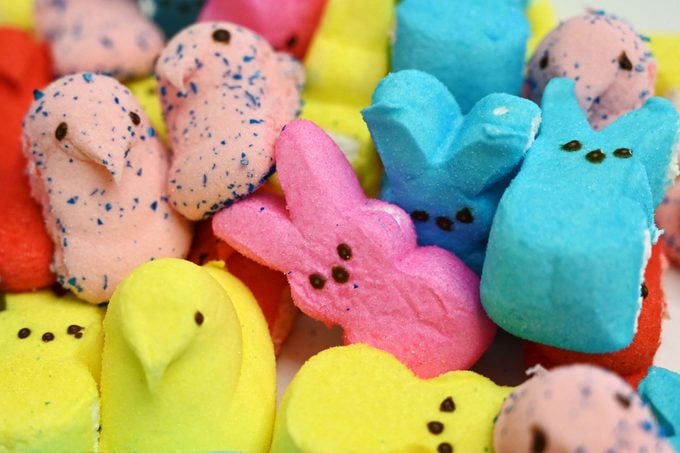
The answer to how are marshmallows made is the same for Peeps! Marshmallow Peeps are most associated with Easter (and Easter baskets), but with they’re available all year round. About 2 billion Peeps are made each year, with themed marshmallow treats celebrating nearly every holiday from Valentine’s Day to Halloween. Like other marshmallows, Peeps are made from sugar, corn syrup, and gelatin derived from pigs. Unlike other marshmallows, they come in innumerable flavors, such as pumpkin, vanilla, and even hot tamale, and food dye means that they can be found in every color of the rainbow.
Their distinctive shapes come from the manufacturing process, where the marshmallow mixture is extruded into a cute chick or egg shape over a conveyor belt. The Peeps are then showered with colorful sugar for that distinctive crackle, and zapped with lasers to give them those cute little eyes.
How long do marshmallows last?
While marshmallows may not go bad in the way that milk does, or stale like crackers, they do have a shelf life. Unopened marshmallows kept in their airtight packaging should last at least until their best-by date, and probably for one to two months after that (assuming they have not been exposed to extreme temperatures).
Once opened, though, you’ll want to eat those marshmallows in about a week. Open marshmallows can harden up, which makes them unpleasant to eat, while those in hot or humid environments can get sticky and melt together in the package. In both of those cases, the marshmallows are still safe to eat; they just won’t taste as good as fresh marshmallows. You can even freeze marshmallows—just pop them into an airtight bag (or use the unopened packaging), and stick them in the freezer. You can then melt frozen marshmallows straight into hot chocolate or s’mores, or leave them on the counter for up to 30 minutes to defrost. But, as always when assessing food quality, it’s best to rely on your eyes, nose, and common sense. If they seem off, don’t eat them!
Now that you know all about marshmallows, find the answers to some other pressing food questions, such as what a macchiato is and where vanilla flavoring comes from.
Sources:
- National Confectioner’s Association: “Marshmallows”
- Chemical & Engineering News: “What’s in marshmallows, and how do the ingredients work together to make ooey-gooey treats?”
- Healthline: “What Is Gelatin Good For? Benefits, Uses and More”
- Marshmallow USA: “About Doumak”
- GlobeNewswire: “North America Marshmallow Market”
- Today: “See how marshmallow Peeps are made, from start to finish”
- Business Insider Australia: “How candy company Just Born makes 5.5 million Peeps a day”
- DoesItGoBad.com: “Do Marshmallows Go Bad?”

